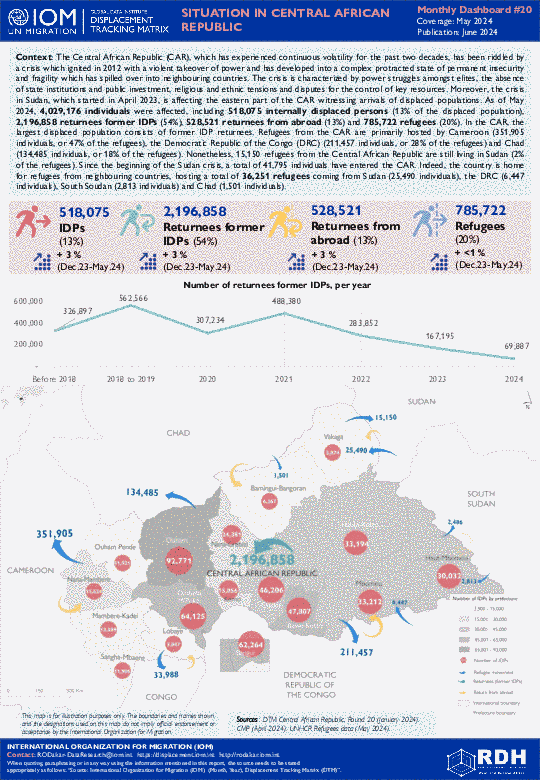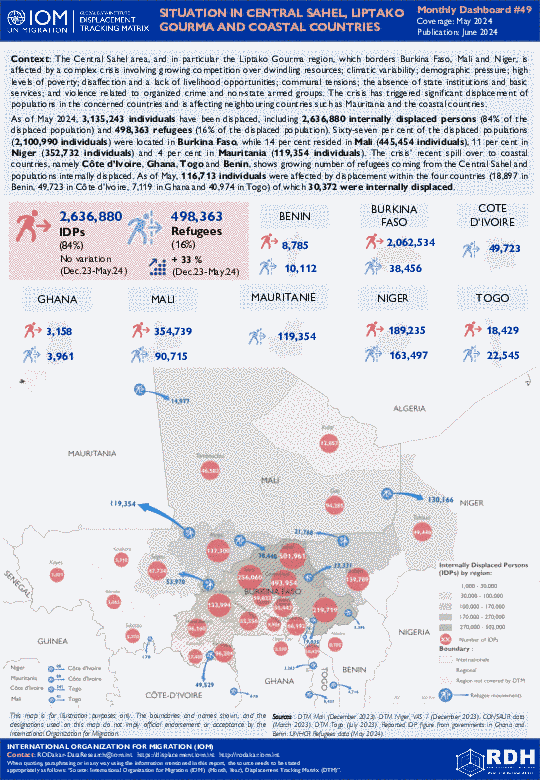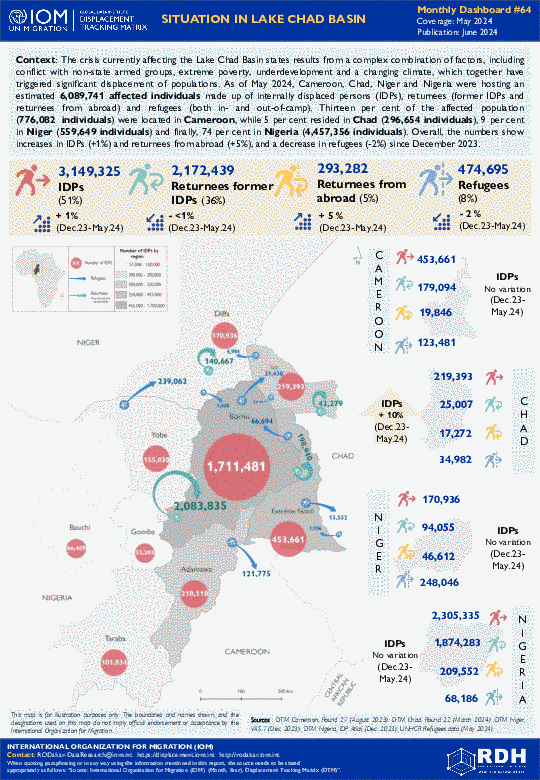-
Countries
-
Data and Analysis
-
Special Focus
-
Crisis Responses
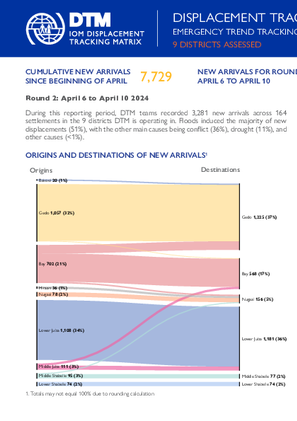
Contact
DTM Somalia, IOMSomaliaDTM@iom.int
Language
English
Location
Somalia
Period Covered
Apr 06 2024
Apr 10 2024
Activity
- Mobility Tracking
- Baseline Assessment
This latest round of Emergency Trends Tracking was initiated in April 2024 to monitor displacements movements during the Gu rainy season. Districts covered in this round include Afgooye, Afmadow, Baardheere, Baidoa, Balcad, Garoowe, Jamaame, Kismaayo, and Luuq.
ETT is a crisis-based tool that tracks sudden displacement triggered by specific events or emerging crises. The objective of ETT is to help prioritize humanitarian response and to enable partners to deliver rapid assistance. Based on previous shock induced displacement patterns, the humanitarian community expects that people will continue to move toward urban areas in search of humanitarian services. Consequently, the ETT coverage focuses on the main urban centers and surrounding villages for each assessed district. The data is collected through Key Informant Interviews (KIIs) at the location level, from Sunday to Wednesday every week. It includes information on new arrivals, numbers and demographic of IDPs, reasons for displacement, intentions, humanitarian assistance and priority needs among others. To facilitate the joint analysis of the CCCM (Camp Coordination and Camp Management) Cluster’s New Arrivals Tracker (NAT) and ETT data, the assistance and needs indicators are identical in both tools.
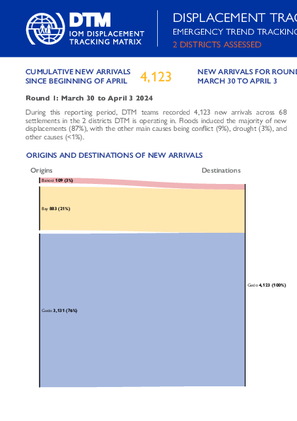
Contact
DTM Somalia, IOMSomaliaDTM@iom.int
Language
English
Location
Somalia
Period Covered
Mar 30 2024
Apr 03 2024
Activity
- Mobility Tracking
- Baseline Assessment
This latest round of Emergency Trends Tracking was initiated in April 2024 to monitor displacements movements during the Gu rainy season. Districts covered in this round include Baardheere and Luuq.
ETT is a crisis-based tool that tracks sudden displacement triggered by specific events or emerging crises. The objective of ETT is to help prioritize humanitarian response and to enable partners to deliver rapid assistance. Based on previous shock induced displacement patterns, the humanitarian community expects that people will continue to move toward urban areas in search of humanitarian services. Consequently, the ETT coverage focuses on the main urban centers and surrounding villages for each assessed district. The data is collected through Key Informant Interviews (KIIs) at the location level, from Sunday to Wednesday every week. It includes information on new arrivals, numbers and demographic of IDPs, reasons for displacement, intentions, humanitarian assistance and priority needs among others. To facilitate the joint analysis of the CCCM (Camp Coordination and Camp Management) Cluster’s New Arrivals Tracker (NAT) and ETT data, the assistance and needs indicators are identical in both tools.

Contact
DTM Europe, DTMMediterranean@iom.int
Language
English
Location
Slovakia
Period Covered
Jan 01 2024
Mar 31 2024
Activity
- Survey
- Return Intention
- Flow Monitoring
IOM’s Displacement Tracking Matrix (DTM) collected data on Ukrainian nationals and Third-Country Nationals (TCNs) that crossed back to Ukraine from or through Slovakia, either temporarily or permanently. The survey focuses on the return intentions, duration of displacement, destinations, assistance, and experiences of discrimination of respondents. A total of 1,335 surveys were collected between January and March 2024.
Key findings:
- 27% of Ukrainian respondents intend to stay in Ukraine (prospective returnees), while 68% plan to go for a short visit.
- The share of those intending to return to Ukraine is higher among men than women (49% vs 25%). Women are more likely to be crossing into Ukraine for a short visit than men (69% vs 44%).
- Most of the short-term visitors plan to stay in their own home in Ukraine (78% overall), while others report to be going to their relatives’ homes (10%), finding other private solutions (7%) or staying with friends (4%). The share of those planning to stay at home is higher among prospective returnees (98%) than among short-term visitors (78%).
- Reasons for returning for prospective returnees include: visit relatives or close friends (75%), meet with family members (6%), reunite with their family (6%).
- Reasons for returning for short-term visitors include: visit family members (76%), healthcare (26%), reunite with family (21%).
- 64% of the Ukrainian nationals originate from seven regions in Ukraine: Zakarpatska (21%), Kyiv (13%), Kharkivska (8%), Dnipropetrovska (8%), Odeska (6%), Zaporizka (3%), and Mykolaivska (3%). The remaining 36% of respondents come from another 20 regions across Ukraine.

Contact
Idiam Osorio, iosorio@iom.int
Language
English
Location
Panama
Period Covered
May 01 2024
May 26 2024
Activity
- Flow Monitoring Survey
- Flow Monitoring
The province of Darien is located on the eastern border of Panama and its territory is one of the migratory crossings most used by people on the move through the Americas, from the south to the north of the continent. This crossing is highly dangerous due to the geographical characteristics of the Darien National Park and the presence of organized crime. People who transit it are exposed to various risks such as human trafcking, smuggling, gender-based violence, various forms of exploitation and abuse. The use of these unsafe crossings to reach temporary or fnal destinations poses threats to the integrity, dignity, and lives of migrants.
Currently, Panama maintains the Operation Controlled Flow active, which provides humanitarian assistance and transfers hundreds of migrants daily from the Temporary Migrant Reception Centres (hereinafter, ETRM) in the province of Darien to the Temporary Attention Centre for Migrants (CATEM) in Costa Rica. The migrants enter through the communities of Bajo Chiquito and Canaan Membrillo, located in the Embera-Wounaan indigenous region in the interior of the province of Darien in Panama, and are transferred respectively to the diferent ETRMs.
Between 1 and 26 May 2024, 25,761 migrants were registered entering irregularly through the Darien jungle, representing an average of 954 daily entries. In April 2024, the total number of entries was 29,259, a decrease of 12 per cent compared to the previous month.
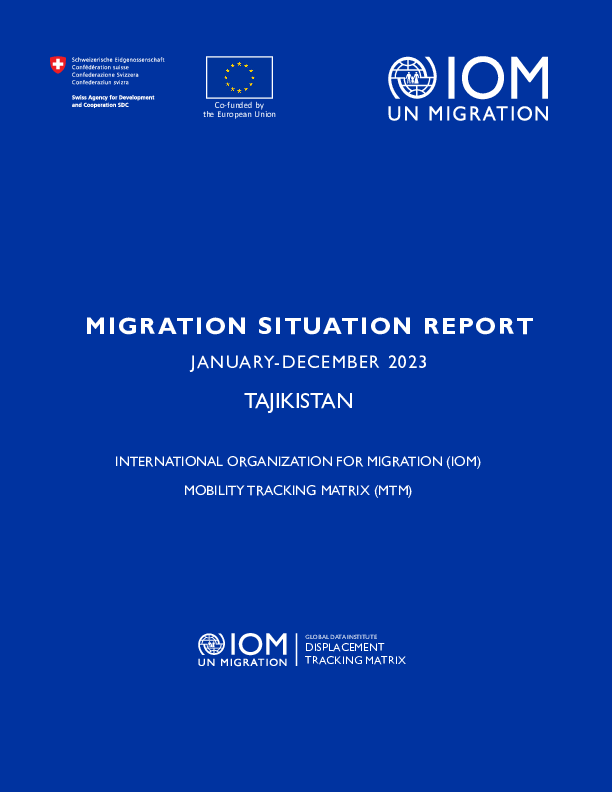
Contact
Contact mtmTajikistan@iom.int
Language
English
Location
Tajikistan
Period Covered
Jan 01 2023
Dec 31 2023
Activity
- Flow Monitoring
- Mobility Tracking
The report aims to provide an overview of the migration patterns and mobility in Tajikistan, drawing upon data from the latest available sources until the end of 2023 from national and international datasets on migratory movements concentrating on the most recent migration situation in Tajikistan. This includes migration flow, number of residences permits and remittances, as well as reasons for migration. The report includes the continuing impact of the Russian invasion of Ukraine on traditional migration corridors in the region, changing labour migration flows, increase of climate change and migration concerns, the growing urbanization process, the social-economic circumstances, and other major events are described as main contributing factors of the human mobility and migratory movements in the given period in the country.
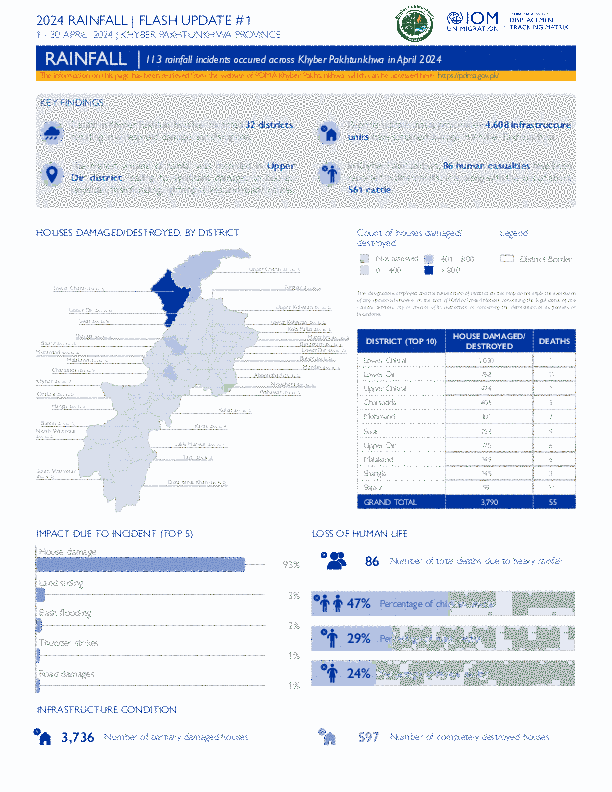
Contact
DTMPakistan@iom.int
Language
English
Location
Pakistan
Period Covered
Apr 01 2024
Apr 30 2024
Activity
- Event Tracking
Rainfall in Khyber Pakhtunkhwa has impacted 32 districts, resulting in widespread damage and disruption. Reports indicate that approximately 4,608 infrastructure units have sustained damage in Khyber Pakhtunkhwa. The highest volume of rainfall was recorded in Upper Dir district, leading to significant damages to houses, landslides, flash flooding, lightning strikes, and road closures. In Khyber Pakhtunkhwa, 86 human casualties have been reported in different districts, along with the loss of about 561 cattle.
Jun 06 2024
Print
Since the start of heavy rainfall from April 2024 in various parts of Pakistan, Khyber Pakhtunkhwa (KP), and Balochistan have been most affected. This operation gives an overview of the affected districts, the extent of the damages to houses and infrastructure, as well as the loss of human life and livestock.
Countries in this response
- Active DTM operation
- Past DTM operation
The Central African Republic (CAR), which has experienced continuous volatility for the past two decades, has been riddled by a crisis which ignited in 2012 with a violent takeover of power and has developed into a complex protracted state of permanent insecurity and fragility which has spilled over into neighbouring countries. The crisis is characterized by power struggles amongst elites, the absence of state institutions and public investment, religious and ethnic tensions and disputes for the control of key resources. Moreover, the crisis in Sudan, which started in April 2023, is affecting the eastern part of the CAR witnessing arrivals of displaced populations.
As of May 2024, 4,029,176 individuals were affected, including 518,075 internally displaced persons (13% of the displaced population), 2,196,858 returnees former IDPs (54%), 528,521 returnees from abroad (13%) and 785,722 refugees (20%). In the CAR, the largest displaced population consists of former IDP returnees. Refugees from the CAR are primarily hosted by Cameroon (351,905 individuals, or 47% of the refugees), the Democratic Republic of the Congo (DRC) (211,457 individuals, or 28% of the refugees) and Chad (134,485 individuals, or 18% of the refugees). Nonetheless, 15,150 refugees from the Central African Republic are still living in Sudan (2% of the refugees). Since the beginning of the Sudan crisis, a total of 41,795 individuals have entered the CAR. Indeed, the country is home for refugees from neighbouring countries, hosting a total of 36,251 refugees coming from Sudan (25,490 individuals), the DRC (6,447 individuals), South Soudan (2,813 individuals) and Chad (1,501 individuals).
The Central Sahel area, and in particular the Liptako Gourma region, which borders Burkina Faso, Mali and Niger, is affected by a complex crisis involving growing competition over dwindling resources; climatic variability; demographic pressure; high levels of poverty; disaffection and a lack of livelihood opportunities; communal tensions; the absence of state institutions and basic services; and violence related to organized crime and non-state armed groups. The crisis has triggered significant displacement of populations in the concerned countries and is affecting neighbouring countries such as Mauritania and the coastal countries.
As of May 2024, 3,135,243 individuals have been displaced, including 2,636,880 internally displaced persons (84% of the displaced population) and 498,363 refugees (16% of the displaced population). Sixty-seven per cent of the displaced populations (2,100,990 individuals) were located in Burkina Faso, while 14 per cent resided in Mali (445,454 individuals), 11 per cent in Niger (352,732 individuals) and 4 per cent in Mauritania (119,354 individuals). The crisis’ recent spill over to coastal countries, namely Côte d’Ivoire, Ghana, Togo and Benin, shows growing number of refugees coming from the Central Sahel and populations internally displaced. As of May, 116,713 individuals were affected by displacement within the four countries (18,897 in Benin, 49,723 in Côte d’Ivoire, 7,119 in Ghana and 40,974 in Togo) of which 30,372 were internally displaced.
The crisis currently affecting the Lake Chad Basin states results from a complex combination of factors, including conflict with non-state armed groups, extreme poverty, underdevelopment and a changing climate, which together have triggered significant displacement of populations.
As of May 2024, Cameroon, Chad, Niger and Nigeria were hosting an estimated 6,089,741 affected individuals made up of internally displaced persons (IDPs), returnees (former IDPs and returnees from abroad) and refugees (both in- and out-of-camp). Thirteen per cent of the affected population (776,082 individuals) were located in Cameroon, while 5 per cent resided in Chad (296,654 individuals), 9 per cent in Niger (559,649 individuals) and finally, 74 per cent in Nigeria (4,457,356 individuals). Overall, the numbers show increases in IDPs (+1%) and returnees from abroad (+5%), and a decrease in refugees (-2%) since December 2023.
